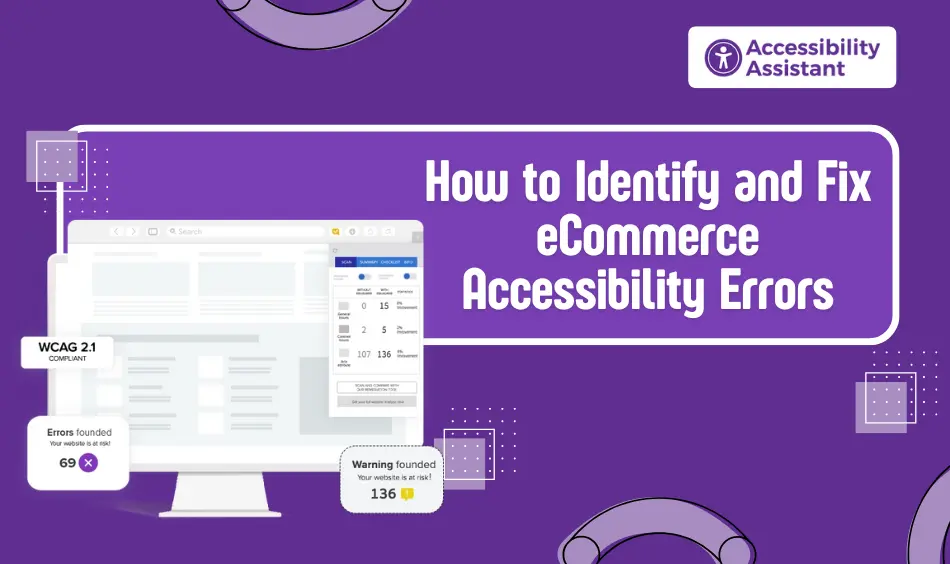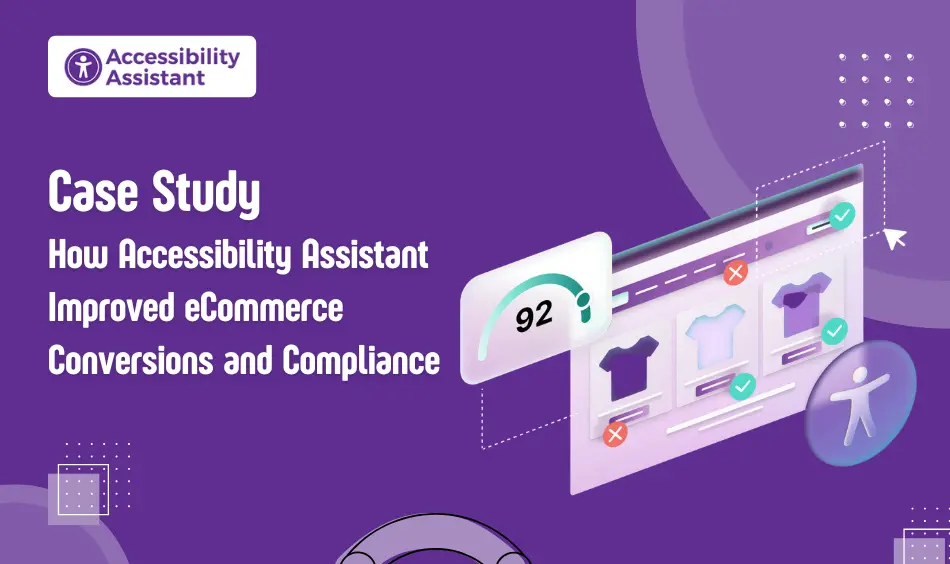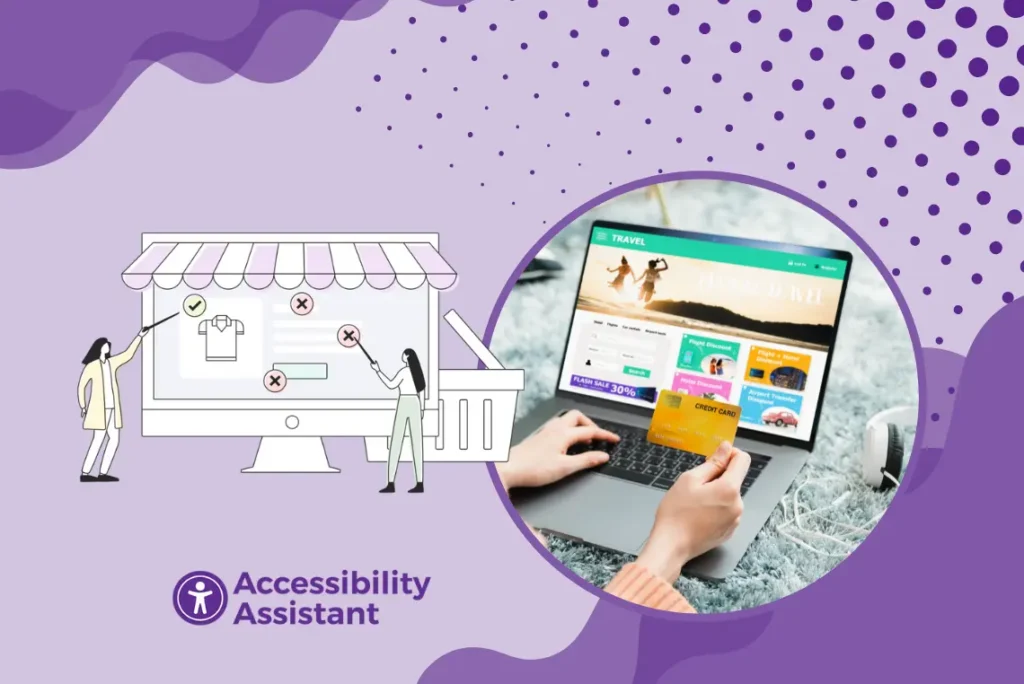Introduction
In 2025, E-Commerce accessibility is not an optional “quality to have.” It’s a legal requirement and a competitive advantage. Whether you’re selling clothing, electronics, or digital products, your online presence needs to be accessible to customers of all abilities; otherwise, you risk losing sales, unfavourable your brand, or even going through lawsuits.
According to a 2020 WebAIM analysis of 1,000,000 homepages, 98.1% of websites failed at least one WCAG 2.Zero compliance checkpoint, with a mean of 60.9 accessibility mistakes according to the web page. These problems, which include terrible color contrast, missing alt text content, and inaccessible paperwork, can make buying hard or impossible for millions of customers.
In this guide, we’ll cover the top 10 eCommerce accessibility errors groups make and provide sensible fixes to ensure your shop is compliant with ADA and WCAG 2.2 standards.
By the end, you’ll know:
- The most common accessibility errors in online stores
- How each issue impacts user experience, SEO, and compliance
- Actionable steps to fix them effectively
- Tools (like Accessibility Assistant for Shopify, WordPress, and Wix) to simplify the process
Common E-Commerce Accessibility Mistakes and Their Fixes
| Mistake | Impact | Quick Fix |
| Low Contrast Text | Hard to read for users with vision impairments | Use a WCAG 2.2 contrast ratio of 4.5:1 or higher |
| Missing Alt Text | Screen readers can’t describe images | Add descriptive alt text for all images |
| Empty Links | Screen readers skip links | Add descriptive anchor text or aria-labels |
| Unclear Link Language | Confuses navigation | Use descriptive, context-specific link text |
| Empty Buttons | Buttons are unreadable to assistive tech | Add visible labels or ARIA attributes |
| Missing Form Labels | Users can’t understand form fields | Add <label> elements linked to inputs |
| Missing Document Language | Incorrect pronunciation by screen readers | Add HTML lang attribute |
| No Keyboard Navigation | Blocks non-mouse users | Ensure tab order and focus indicators are correct |
| Inaccessible Pop-ups | Blocks interaction for screen reader users | Use ARIA roles, allow ESC key to close |
| Lack of Mobile Accessibility | Alienates mobile shoppers | Test with mobile screen readers and adjust touch targets |
How to Identify and Fix eCommerce Accessibility Errors

Accessibility mistakes in e-commerce websites can silently harm income, damage SEO, and place your business at legal risk. Below are the 10 most common problems that E-commerce store owners face, why they matter, and exactly the way to repair them.
1. Low Contrast Text
The Problem:
When text and background colors don’t have enough contrast—such as light gray on white—it becomes hard to read for everyone, especially shoppers with low vision or color blindness.
The Impact:
- Content is inaccessible to a large segment of users.
- Higher bounce rates as visitors leave due to readability issues.
- Violates WCAG 2.2 – 1.4.3 Contrast (Minimum) standards.
The Fix:
Use the W3C Contrast Checker or Accessibility Insights to ensure a minimum 4.5:1 ratio for body text and 3:1 for large text. Test hover/focus states and mobile color displays to maintain compliance across devices.
2. Missing Image Alt Text
The Problem:
Without alt text, screen reader users have no way of understanding what an image depicts, leaving them without crucial context.
The Impact:
- Poor user experience for assistive technology users.
- Missed SEO opportunities—Google indexes alt text.
- Fails WCAG 1.1.1 – Non-text Content requirements.
The Fix:
Write concise, descriptive alt text that explains the image’s purpose. Use alt=”” for decorative images. In 2025, AI-driven tools like Accessibility Assistant can generate accurate alt text at scale.
3. Empty Links
The Problem:
Icon-only links or unlabelled hyperlinks are invisible to screen readers, creating navigation gaps.
The Impact:
- Blocks navigation for assistive tech users.
- Increases ADA compliance risk.
The Fix:
Add descriptive link text or ARIA labels so that all links have a clear, accessible destination.
4. Unclear Link Language
The Problem:
Generic phrases like “Read More” don’t provide context when taken out of page sequence.
The Impact:
- Frustrates screen reader users who navigate by links.
- Violates WCAG 2.4.4 – Link Purpose (In Context).
The Fix:
Use specific link text such as “Read More About Our Summer Collection” instead of “Read More” to give users full context.
5. Empty Buttons
The Problem:
Buttons without labels or descriptive text can’t be read by assistive technology, blocking user actions like checkout.
The Impact:
- Prevents form submissions or purchases.
- Directly impacts sales conversion rates.
The Fix:
Include visible text or ARIA attributes for every button. Ensure <button> elements have either text nodes or value attributes.
6. Missing Form Input Labels
The Problem:
Form fields without labels confuse users and screen readers, especially during checkout.
The Impact:
- Increases checkout abandonment.
- Creates unnecessary friction in form completion.
The Fix:
Use <label> elements linked via the for attribute to input fields. Add clear error message instructions for accessibility.
7. Missing Document Language
The Problem:
Without a declared primary language, screen readers may mispronounce words and content.
The Impact:
- Accessibility issues for multilingual audiences.
- Fails WCAG 3.1.1 – Language of Page standards.
The Fix:
Add <html lang=”en”> or the relevant language code to the HTML tag. For multilingual stores, set language attributes dynamically per page.
8. No Keyboard Navigation
The Problem:
Menus, filters, and checkout processes that require a mouse block keyboard-only users.
The Impact:
- Violates accessibility compliance requirements.
- Excludes users with motor impairments.
The Fix:
Test site navigation with only a keyboard. Ensure logical tab order, visible focus states, and “Skip to Content” links.
9. Inaccessible Pop-Ups and Modals
The Problem:
Pop-ups that trap focus or aren’t announced to screen readers prevent users from interacting with content.
The Impact:
- Interrupts checkout flow.
- Fails WCAG 2.4.3 – Focus Order and 4.1.2 – Name, Role, Value guidelines.
The Fix:
Use ARIA roles (e.g., role=”dialog”), trap focus within the modal, allow ESC key to close it, and return focus to the triggering element.
10. Lack of Mobile Accessibility
The Problem:
A site that isn’t mobile accessible alienates mobile shoppers with disabilities.
The Impact:
- Loss of mobile sales.
- Violates WCAG 2.5.5 – Target Size requirements.
The Fix:
Test using mobile screen readers like VoiceOver (iOS) and TalkBack (Android). Ensure touch targets are at least 24x24px with proper spacing.
Case Study: How Accessibility Assistant Improved eCommerce Conversions and Compliance

In early 2025, a mid-sized apparel eCommerce brand was struggling with high cart abandonment and growing concerns about ADA compliance. Their accessibility audit revealed:
- Hundreds of missing alt text entries for product images.
- Promotional banners with insufficient color contrast.
- Navigation menus and product filters are inaccessible by keyboard.
The Accessibility Assistant Solution:
The brand implemented Accessibility Assistant across its stores to address compliance gaps quickly. Within weeks, they:
- Added alt text to over 1,500 product images, making product visuals accessible to screen readers.
- Corrected color contrast issues on sale banners and homepage sliders, meeting WCAG 2.2 AA standards.
- Optimized keyboard navigation for product filters, menus, and checkout processes.
The Results After 3 Months:
- Cart abandonment dropped by 14% thanks to smoother checkout accessibility.
- Organic traffic grew by 11%, driven by improved SEO from alt text optimization and better semantic HTML structure.
- Accessibility compliance score jumped from 68% to 98%, significantly lowering legal risk.
- Positive customer feedback highlighted “easier navigation” and “faster shopping experience.”
By combining automation with best practices, the brand not only achieved ADA & WCAG compliance but also turned accessibility into a growth driver.
FAQs About the E-Commerce Accessibility Mistakes
Q1: What are common e-commerce accessibility issues?
They include low contrast text, missing alt text for images, inaccessible forms, unclear link text, and non-keyboard-friendly navigation.
Q2: How often should I run an accessibility check on my eCommerce website?
At least quarterly and after every major update to ensure ongoing ADA and WCAG compliance.
Q3: How can I fix accessibility issues quickly?
Use Accessibility Assistant for real-time scanning, automated fixes, and continuous monitoring.
Q4: Does ADA compliance apply to mobile eCommerce apps?
Yes, ADA and WCAG standards cover both websites and mobile applications.
Q5: Can improving accessibility also boost SEO and sales?
Absolutely, accessible websites have better structure, metadata, and UX, which can improve search rankings and increase conversions.
Conclusion
Ignoring eCommerce accessibility isn’t simply risky; it’s a misplaced possibility. By fixing those 10 commonplace mistakes, you’ll not only comply with ADA and WCAG 2.2, but you’ll also enhance search engine optimization, raise conversions, and earn customer trust.

